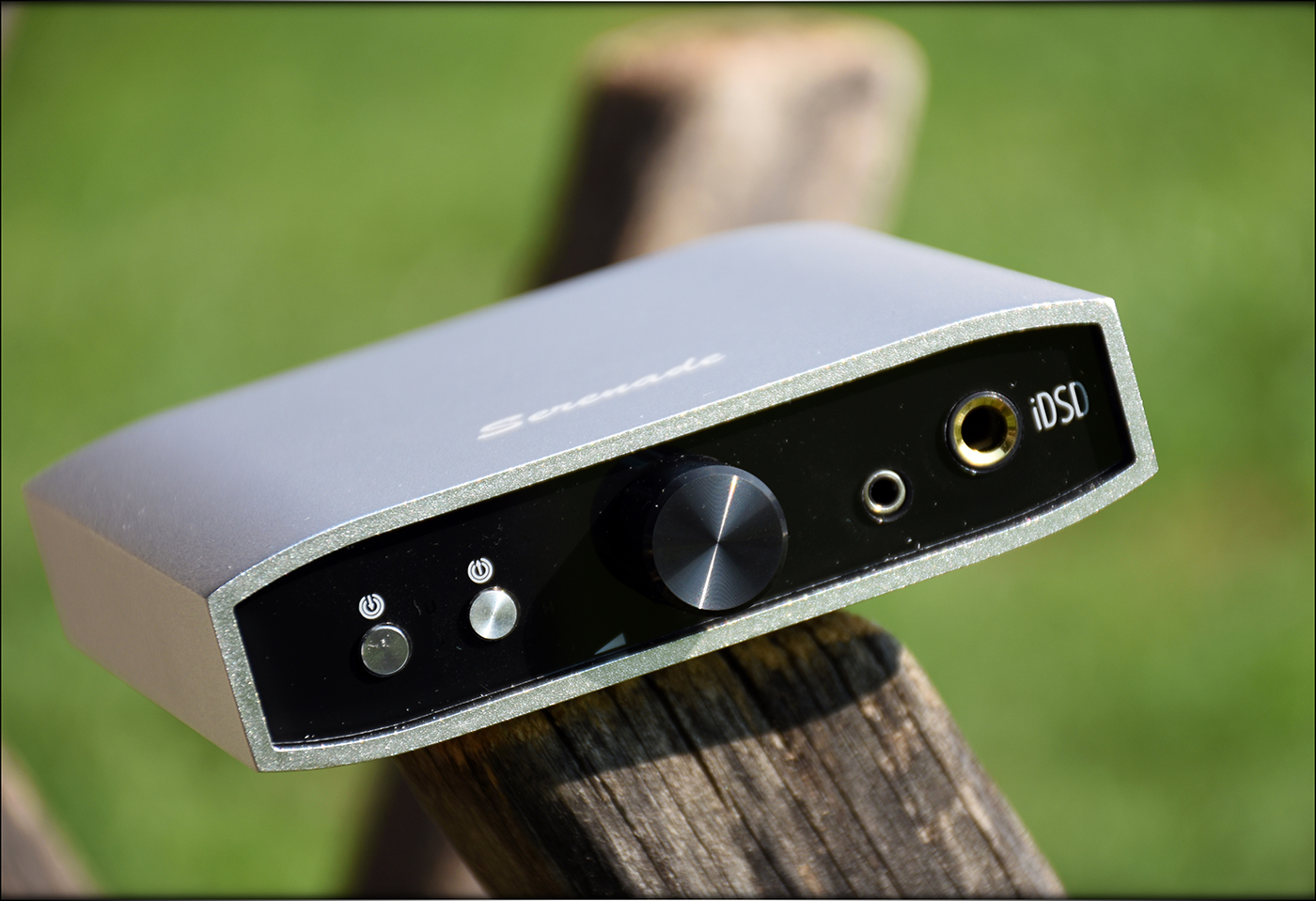

Another interesting invention for us — TEMPOTEC Corporation that specializes on developing and manufacturing PC audio cards and recently focusing and shifting to home audio appliance field. Despite the fact that TEMPOTEC has more than two decades of history, we don’t see its products on the shelves of local stores quite often. Their supply to different parts of the world is definitely present but we haven’t found the overwhelming amount of information or owner feedback about Tempotec devices.
Current Tempotec family has several device lineups: Serenade, Fantasia and Sonata. Sonata is the most portable family of DAC& devices with inbuilt batteries and small dimensions. Fantasia is another extreme — a whole system for the most demanding full-size headphones. Finally, Serenade series includes DAC&s as standalone desktop products with no batteries inside. Moreover, there are PCI-e cards sharing some family characteristics for those who would like to integrate it to their PC-based sound or gaming workstation.
After getting more familiar with current Tempotec series of products, we would try to correct our own mistake of not following such weighty industry names by examining and reviewing Tempotec relatively new device — Serenade iDSD standalone DAC& which is aimed to upgrade any digital audio source to HiRes audio standards.
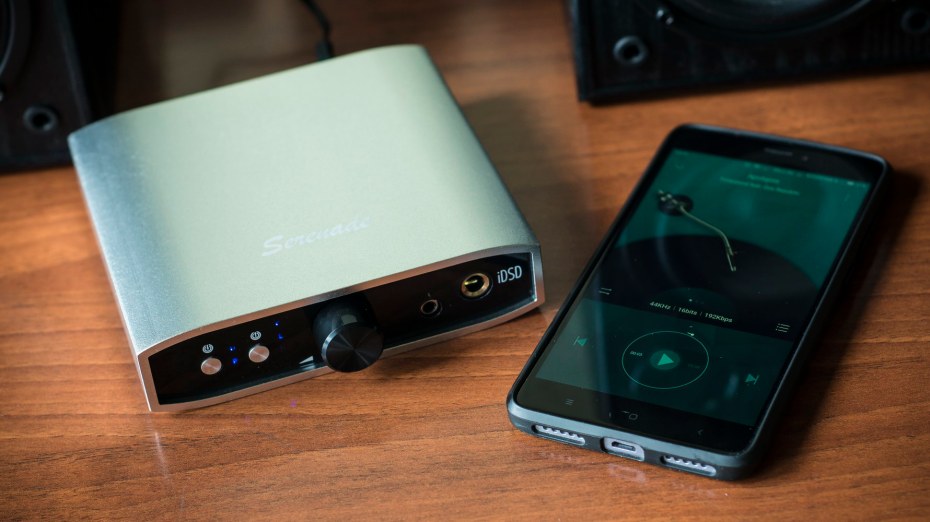
Technical Specifications:
- Type: USB DAC& Amplifier
- CPU: HiBy CPU
- DAC: AKM AK4490EQ
- Amp: Ti TPA6120A2
- OPAmp: Ti LME49720NA
- PCM Support: 32-Bit/192KHz
- Frequency Response: 0Hz — 50KHz
- THD + N: 120dB
- DSD Support: DSD 64/128 (native | DoP)
- Stereo Isolation: 120dB
- Headphone Output Power: 300mW / 32Ohms | 75mW / 600 ohms
- Inputs : USB type A, USB type B
- Outputs: 3.5mm & 6.3mm audio heaphone jack, RCA, Coaxial
- Controls: Volume knob, Input selection button, Output selection button
- Power supply: DC, 5V (power adaptor included)
- Material: aluminum-alloy
- Dimensions: 130mm X 120mm X 30mm
- Weight: 412g
- OS: Windows 7,8,10; MAC OS; Android (normal/private modes), iOS

Box contents:


Serenade iDSD comes in large carton box filled with soft foam rubber as a retainer and includes just a few additional accessories:
- Serenade iDSD
- DC, 5V switching power supply
- USB type B -> USB type A cable
- Plastic stands x2
- Chineese user manual

Not very rich box contents but enough to cover the main instance of connecting to PC or Mac.
Additionally, you might need USB type B -> microUSB/USB type-C adaptor to connect to Android OS smartphones or USB type A -> microUSB/USB type-C to connect to iOS or Android smartphones in private mode if the first option failed.
Design and build quality:
Serenade iDSD case (acting as chassis) is made of thick alluminum-alloy with plastic front and metal back parts. Front part consists of two input/output selection buttons and corresponding blue LEDs, analog volume pot and two headphone outputs: 3.5mm and 6.3mm.

Back panel is occupied by power ON/OFF switch, RCA L+R lineout, Digital coaxial, power jack input, USB type A and USB type B inputs.
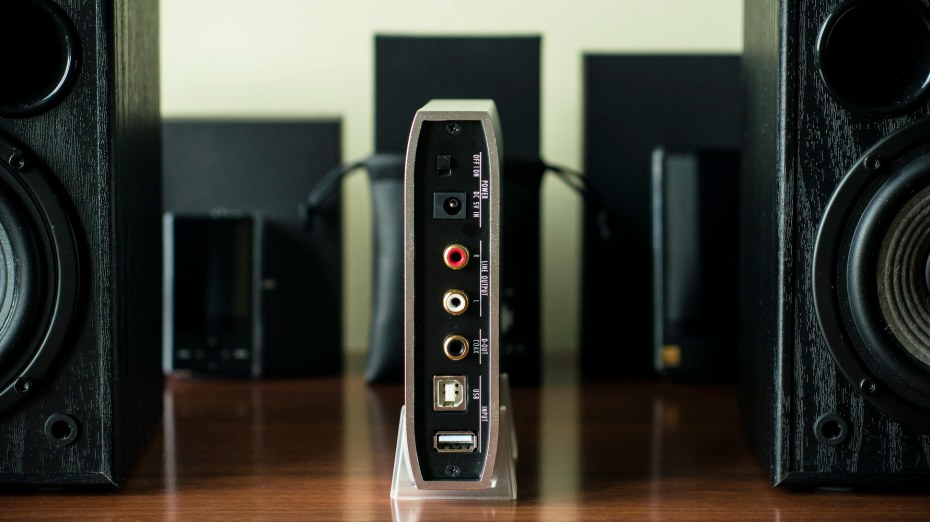
Plastic stands do a great job of holding the device in vertical position allowing it to dissipate heat effectively.
Overall build quality is on a very good level. Nothing rattles inside, all elements are neat and all labels are accurate enough to create first positive impression. Almost half of a kilo weight is reasonable concerning thick alluminum chassis.
Hardware part:
This is the most peculiar part that allows us to belive that Serenade iDSD is a very good bargain:
- it is based on mighty Asahi Kasei AK4490EQ premium line DAC which can also be found in DACs of such brands as Denon, Teac, Marantz, Onkyo, Esoteric and so on…
- it is capable of up to 32bit/192kHz
- it uses Texas Instruments TPA6120A2 high fidelity stereo headphones amplifier + Ti LME49720 high fidelity OPAmp that would drive 600Ohms loads at 75mW.
- it utilizes Nichicon Line Gold series capacitors
- its CPU is specially designed for HiRes audio performance by HiBy
- etc…
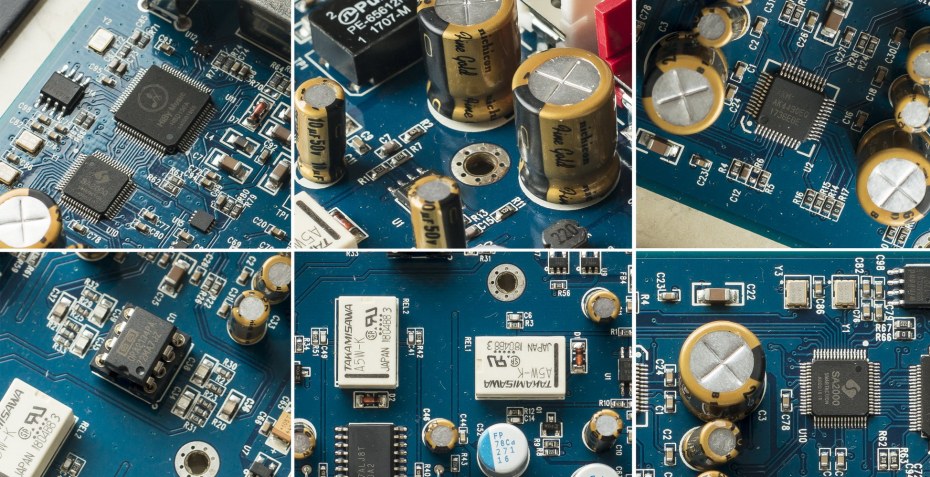
Moreover, although it is not stated in the description, OPAmp is not soldered and easily swappable. This also adds some value to the device for those who would like to conduct further experiments to the resulting sound.
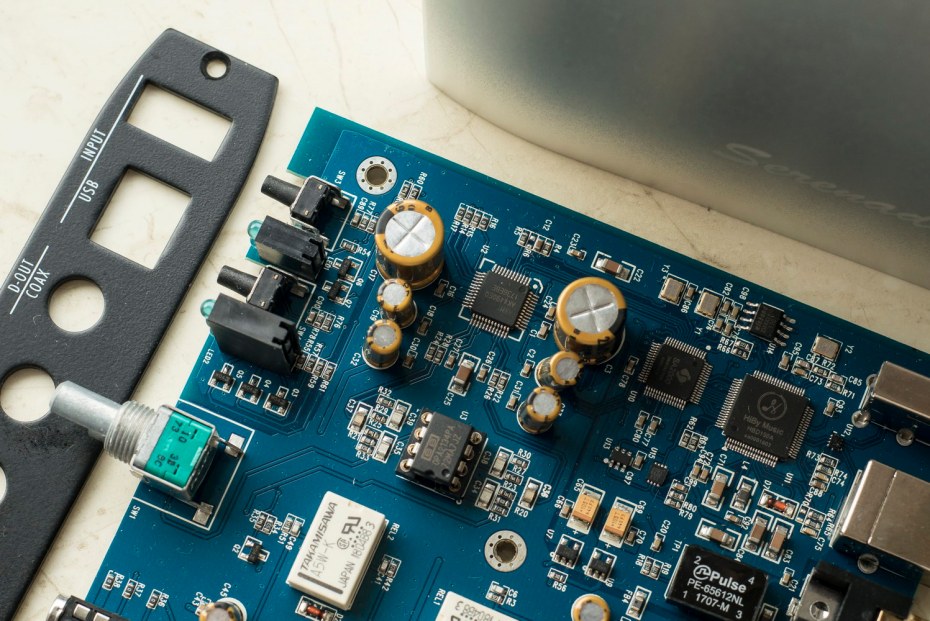
BTW, tearing down Serenade iDSD is very easy — it is a matter of unscrewing just 2 screws on the back panel, removing volume pot (pulling it off) and unscrewing large nut that holds volume potentiometer at place.

Soldering and the whole circuit board looks to be assembled very carefully. There are no signs of neglect soldering or cheap mass production processes.
Device operation:
There are two usage scenarios in terms of inputs and other three in terms of outputs.
First of all, we have tried to connect is to Win10 OS based PC. USB B -> USB A cable is included and the only trick to make it work is to locate the appropriate drivers. In order for Serenade to run with PC you would have to use front buttons and set left one (input) at «U» (which means USB) and right one (output) to either of three options which are: «C» (coaxial), «L» (lineout), «H» (headphones).

Windows 10 would recognize this device as Tempotec external DAC and allow to direct audio stream by the means of Wasapi (from Foobar2000) with almost non-existing audio lag.
Other option is to use Serenade iDSD with a smartphone. Our testing device is Xiaomi Redmi Note 4 which works perfectly with HiByMusic app and through USB A -> microUSB cable and using input «P» (private mode input) on the front panel. Output options are limited to lineout and headphones in this case. Coaxial output would only work while «U» input is selected.
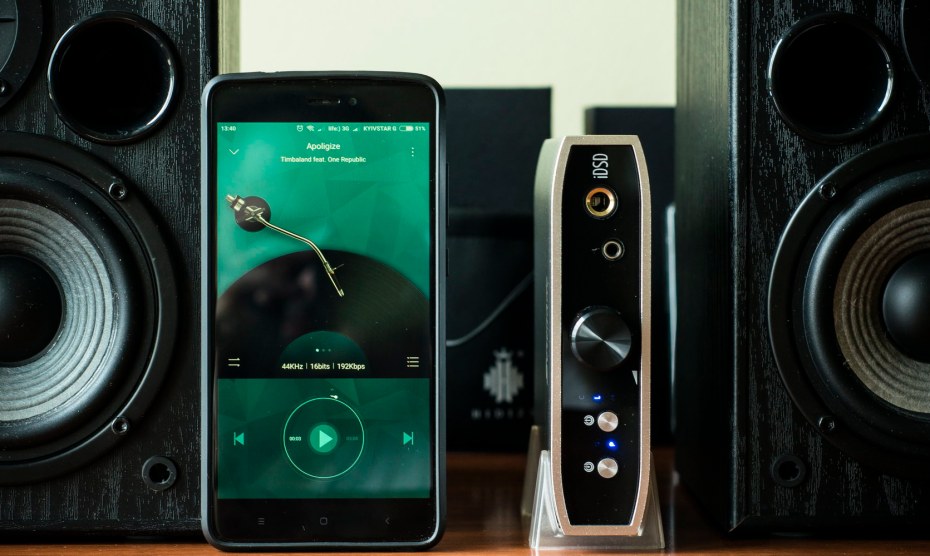
And the last option which wouldn’t be used often is digital transport — connecting PC to Serenade iDSD and using digital output (coaxial) to pass the stream further…
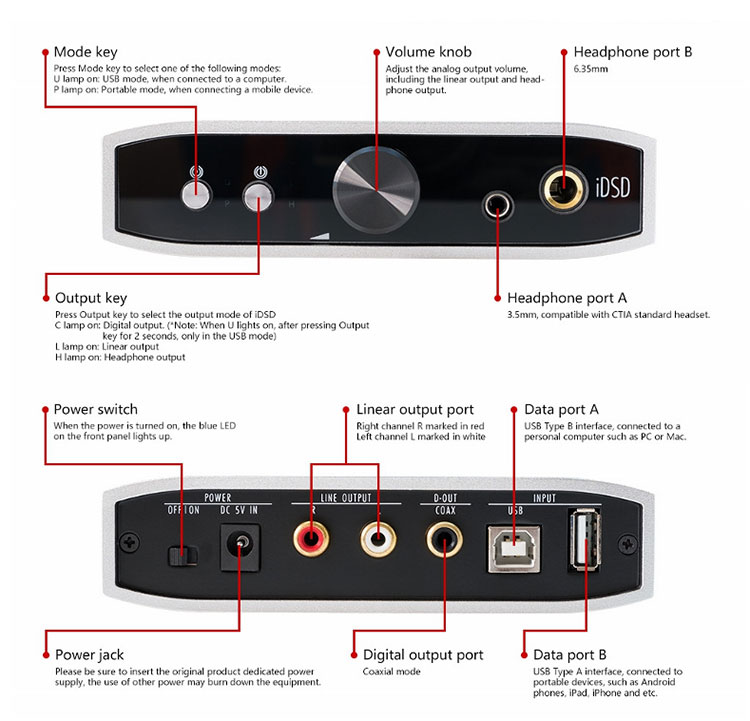
Concerning the fact that Serenade iDSD is not intended to be carried around and it doesn’t have autonomous power source — our main usage scenario would be connecting it to PC and listening music through headphones, active speakers or passive speakers with power amplifier and iDSD playing pre-amplifier role. All options are perfectly usable and moreover, there is no need to disconnect either of the output devices thanks to output selection button.
One little negative point - unfortunately, volume pot would not utilize its full mechanical travel. Max volume is reached at about 85-90% of travel and there is no further influence.

Please note that Serenade iDSD heats up to ~38-42°C while operating and it is better to keep it standing vertically to avoid excessive heating or damage to desk surface.
Sound quality:
As always, we would try to compare instead of writing only about Serenade iDSD sound quality. The essence shows up only in comparison… Our comparison would be done to Hidizs Sonata DH1000 which is portable, battery-equipped DAC& with the additional balanced output and which audio quality is respected by many owners who bought their units recently and comapred to other more expensive rivals. Sonata DH1000 is a real beast in terms of high fidelity audio due to enhanced and complicated hardware architecture and despite a compact formfactor. In order to get a closer look — here is a link to out review of Hidizs Sonata DH1000. We would also be using our favorite pair of full-sized monitor headphones — Audio-Technica ATH-M50 (38Ohms), plus a good pair of high quality IEMs — Dawnwood ST08 (18Ohms).....

Maaaaaannn!!! Tempotec Serenade iDSD sounds very good. It doesn’t matter whether the direct comparison is done to a mighty Sonata DH1000 or it was a separate session of audio listening experience — Serenade iDSD has very matured and engaging sound.
First what we’ve noticed was a bit of emphasis on lows that is a pefect choice for IEMs that always trail behind full-sized ATH-M50 in this aspect. Don’t get us wrong — lows are not overpowered or overemphasized — they are just at the right spot. Sonata DH1000 acts more gentle in this respect and would be a better match for ATH-M50 that tend to more low-end.
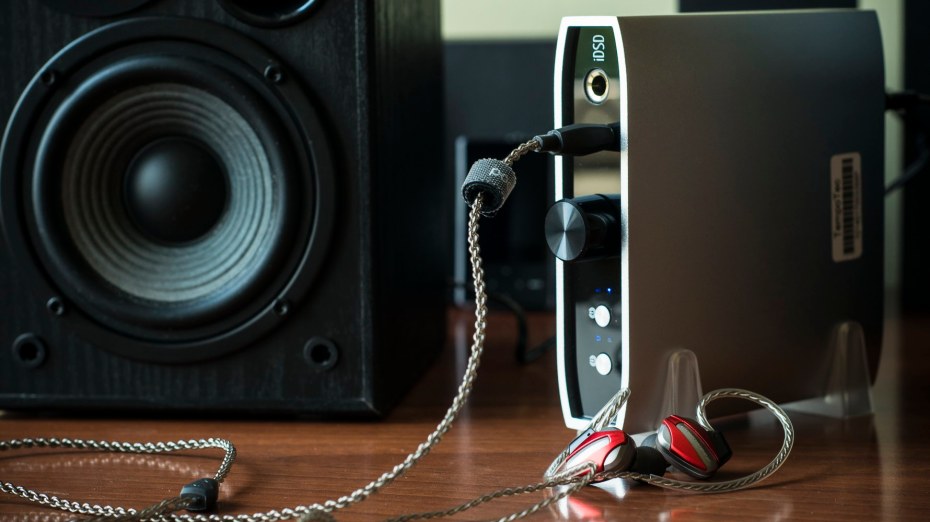
Midbass section is very powerful and punchy which is not a surprise for such output ability of amplifier section. 300mW at 32Ohms results in very good driving potential and really makes you feel each drum hit that is so energetic as if you are standing next to it. Sonata DH1000 does the same but its output power is two time less which would result in lower driving ability for loads higher than 150Ohms.
Highs do not disappoint either — very good resolution of smallest details, no harsh sounds and no hissess. Top is in good balance with the overall sound picture of this device. Seems to be on par with Sonata DH1000 with a bit of advantage in transparency in DH1000 top-end.
Sound stage is wide with good horizintal and vertical instrument separation and vocals standing a bit in front of the entire scene. The most interesting fact is that despite using a single DAC + amp Serenade iDSD sound stage is just a fraction less to Sonata DH1000 which utilizes double DAC&Amp architercure to get the most channel separation…

Finally, after spending countless hours with both devices — we came to the conclusion that we can hardly find significant difference in their audio performance apart from different low-end signature and some more intimacy and gentleness in Sonata DH1000 sound. Both have excellent audio quality and both should be considered as a great bargain. The only case when their differences really come into play is when we start to think about their additional capabilities and usage scenarios… In this respect — they are very different indeed.
Let’s do a final comparison in terms of base and additional features:
Tempotec Serenade iDSD:
Pros:
- High power output (300mW @ 32Ohms, up to 75mW @ 600Ohms)
- 32bit/192kHz
- Swappable OPAmp
- Lineout
- Enhanced low-end
- Excellent sound quality, especially with higher loads or IEMs with no emphasis on lows
- Price
- Desktop usage only
- Requires additional power supply
- No balanced headphone output
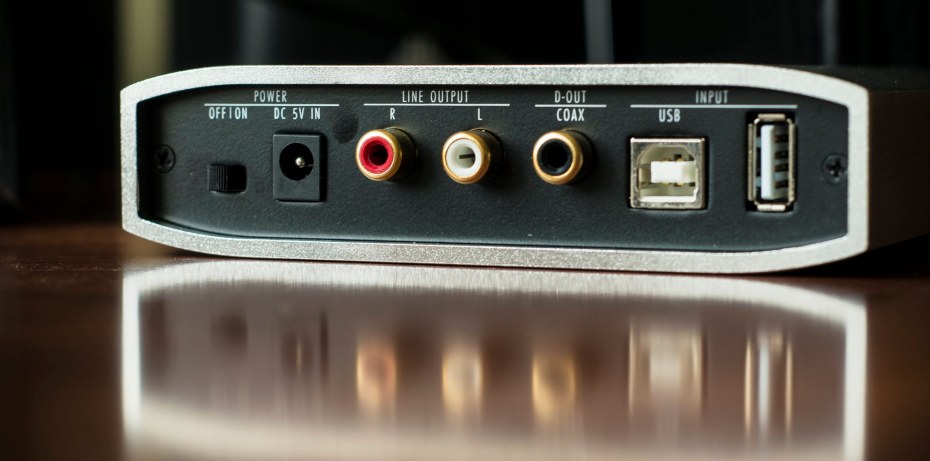
Hidizs Sonata DH1000:
Pros:
- 3.5mm unbalanced + 2.5mm balanced output
- double DAC& design
- portable, has autonomous power
- excellent sound quality with any headphones
- Price is higher
- Less powerful output (150mW @ 32Ohms balanced, 120mW @ 32Ohms unbalanced)
- No dedicated linout
Conclusion:

As a matter of fact, we are really impressed with Tempotec Serenade iDSD performance. This is the first device from Tempotec we’ve ever held in our hands and it exceeded our best expectations. Since the time we’ve reviewed Sonata DH1000, we thought that it would be a long wait for another device to take over or at least to stand in line… but the day has come — Serenade iDSD could be considered as the closest rival in terms of audio quality with just a fraction of simplicity in overall sound signature and at a way less cost. Though, it cannot be considered as 100% substitution due to almost completely different possible usage scenarios… Therefore, you get a choice of two perfect options and for a different budget… isn’t that’s great?
Last edited by a moderator:



 Any hints on that?
Any hints on that? I admire your attitude
I admire your attitude  BTW - there are other positive reviews about this DAC&. Sound is definitely good and the whole experience as well. Hope that you'd be satisfied. Waiting for your further comments upon arrival.
BTW - there are other positive reviews about this DAC&. Sound is definitely good and the whole experience as well. Hope that you'd be satisfied. Waiting for your further comments upon arrival.